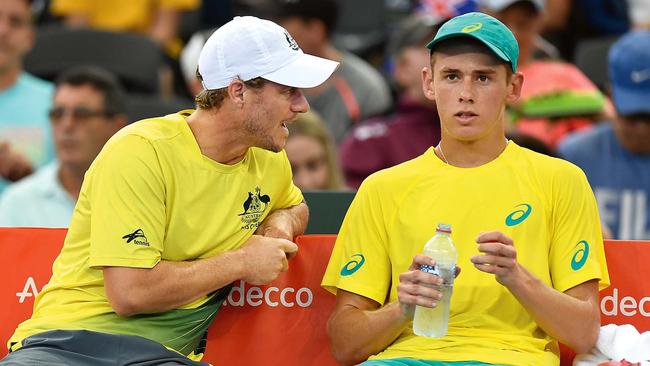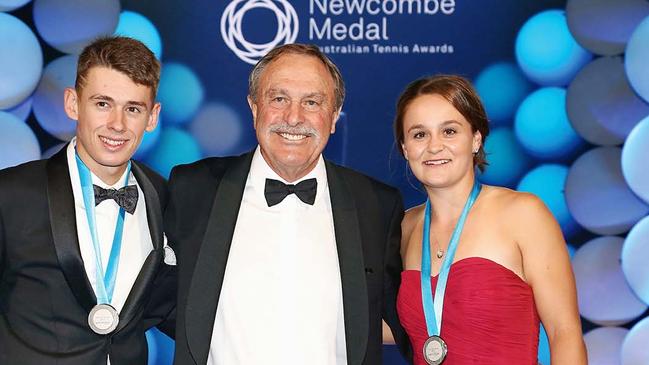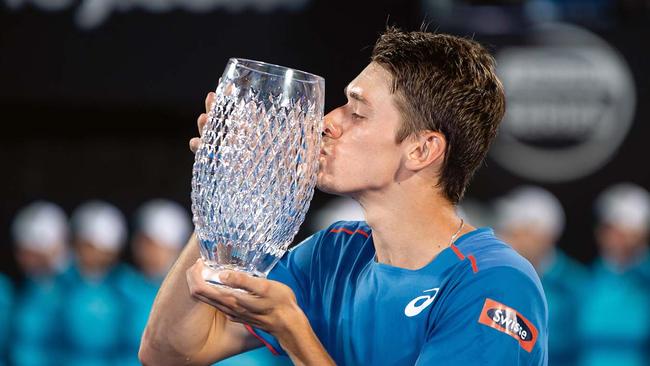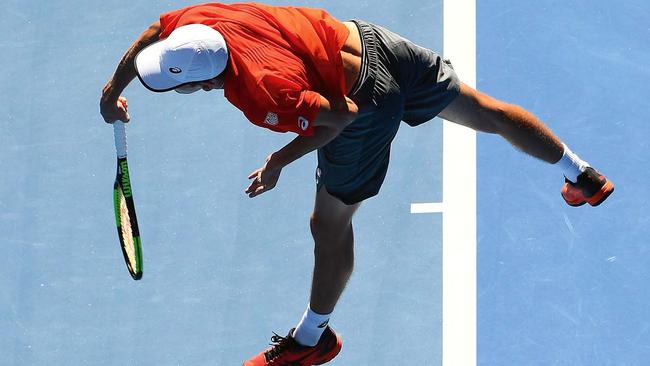Arise Alex de Minaur, next great hope of Australian men’s tennis
Still just 20, he’s our top men’s player. As Wimbledon nears, does Alex de Minaur have what it takes?

It takes a special something to win over a New Yorker, but on a typically sticky September night last year, Alex de Minaur had fans hollering his nickname. Dee-mon! Dee-mon! Dee-mon! The crowds who flock to the US Open are considered the toughest tennis critics of all. Fellow Aussies Nick Kyrgios and Bernard Tomic have earned their wrath more than once in recent years, booed off the courts and out of New York. De Minaur, the new Australian men’s No.1, is distinct in style from that pair — from his desire on court to his taste in classic cars, his preference for a chess board over a video game. And in his certainty that this is where he wants to be. Give him a tough match, ask the impossible, and he’ll keep fighting.
As the clock ticked beyond 2am and the last commuter trains rattled through Queens and out to Long Island, de Minaur engaged in a stirring comeback against 2014 US Open champion Marin Cilic. Sensing they were seeing something special, the fans crowded into Louis Armstrong Stadium were suddenly wide awake and bellowing for the “Demon”. It’s a nickname dreamt up by Tomic and Kyrgios years earlier when de Minaur was a Davis Cup “orange” boy. They were amused as much by his cheeky, though polite, demeanour as they were impressed by his intensity and ethic on court.
It was a wild thriller that finished just shy of a historically late finish that night when Cilic finally gained the better of de Minaur at 2.22am. But the young Australian’s determination through the fifth set fightback marked him as a real talent. This was tennis as a chess match. He showed his brain could match the brawn of the more experienced Croat, a former Wimbledon and Australian Open finalist. De Minaur gave his all, every single point. In desperate need of a bed when he staggered into a press conference after 3am, his assessment was succinct. “Every time I step on to court, I tell myself that I am going to fight until the last point,” he said.

After the match Darren Cahill, who has coached Lleyton Hewitt, Andre Agassi and Simona Halep to world No.1, declared Australia had “a lot to look forward to over the next 10 years”. And other players on the circuit took notice, voting de Minaur the ATP Tour’s Newcomer of the Year: in the course of 2018 he rose 177 places in the world rankings, from 208 to 31.
Just seven months ago de Minaur, now 20, was sharing the podium with another fresh-faced Aussie, Ash Barty, as the first joint winners of the Newcombe Medal. Just as Barty had promised great things before achieving the ultimate success at the French Open in Paris two weeks ago, de Minaur — the world No.24 at the time of going to press — has produced enough to suggest we may be on the cusp of a new golden era of tennis. His drive and talent has already taken him to the sport’s biggest stages, from Wimbledon’s centre court to a maiden career title at the Sydney International this January, and from Melbourne to Milan, where he was a finalist last November in the ATP Tour’s Next Gen Championships, pipped by the Greek sensation Stefanos Tsitsipas.
De Minaur is living the dream he chose to pursue aged 12: a life spent travelling the globe as a tennis player. As he reflected while departing Louis Armstrong Stadium: what a wonderful world it is. “The most important thing is that I am fortunate enough to do something I love every single day of the year,” he tells me. “Not many people can say that their job is their passion. I just have to remember that.”

Esther de Minaur was strolling through the Sydney suburb of South Hurstville in 2004 when a flyer caught her eye: Tiny Tots Tennis. How cute, she thought. Her then four-year-old Alex was an energetic soul and this activity sounded fun. Esther, who grew up in Spain, had arrived in Sydney in 1996, and while waitressing at an Italian restaurant called Giovanni’s on George Street fell in love with Anibal, an immigrant from Uruguay who owned the business. They eventually married and settled down to have a family — Alex and his younger siblings Dominic, Christina and Sara.
The tiny tot Alex arrived for that first lesson in South Hurstville with a racquet “bigger than he was”, Esther recalls. The coach turned to some ladies on the adjacent court and shouted: “OK. The next Australian Open champion is here.”
“From the moment Alex first hit the ball, the coach came to me and told me, ‘I am not the coach for him. I have coached around the world and I have never seen anyone as co-ordinated as him who is so young’,” Esther says. So the youngster was enrolled in a private tennis academy and there was no getting him off the court.
When Alex was six the family moved to Spain to live in Alicante, a port city on the Mediterranean. Anibal de Minaur had noted the potential of opening car wash cafes in Spain and, with Esther’s family based there, the decision was made. It was there, while playing in his first tournament at the age of seven, that young Alex first tasted the emotion that would shape his life in tennis — “the competitive spirit, the adrenalin of winning that match,” he recalls. “Once I started competing, I realised this was what I wanted to do. I loved being out there on court and having to almost play like a chess game against your opponent, to realise their weaknesses and try to exploit them.”
Chess, as it turns out, has been an important tool in de Minaur’s development. As a boy, he would play for hours with his brother Dominic while his father monitored their progress, occasionally joining in to up the challenge. Unfortunately, very few of de Minaur’s peers on the tour are proficient at the board game, but he still plays when he can. “I find that it helps keep the mind active and I enjoy having to think a couple of moves ahead, thinking of the consequences of your move, the tactical elements of it,” he says.
Anibal stressed the importance of all his children learning chess. “He believes it teaches you many things about patience, the importance of making the right move, of reading your opponent,” Esther says. A link can be drawn between the board game and the way de Minaur approaches his sport, according to Tennis Australia CEO Craig Tiley. “It is a metaphorical link you can make with chess,” he says. “He is a thinking player. He likes the challenges of competing and his planning on the court… you watch him in his matches and he makes different adjustments to counter his opponent. The discipline of chess and the deliberations, the planning for future moves, adjusting to get a good outcome, I think chess has similarities.”
By the age of 11, de Minaur was excelling in Spain under the tutelage of coach Adolfo Gutierrez, having seen off a future in soccer amid protests from his football mentor that he could be the next Ronaldo. De Minaur was then Spain’s top-ranked tennis player for his age — but when the global financial crisis hit the family’s car wash business was badly affected, so Anibal opted to return to Sydney to oversee Giovanni’s, which had been run in his absence by his son from a former marriage. The rest of the family stayed in Spain.
The economic strain also threatened Alex’s development in tennis — which, given its global nature, is an expensive sport. The prize money at the highest level is immense, but financing the coaching and travel is significant — and there’s no guarantee of success.
Gutierrez, who remains de Minaur’s coach and is a family friend, offered to coach for free to help out during these tough times. “It is really simple: I believed in Alex,” he says. “I believed he could make it and I had a personal relationship with him and his family and I wasn’t going to let him down. Life is not all about economic gain.”
But still, the de Minaurs could not afford to take their boy to tournaments. It is here that Tennis Australia, which had kept an eye on the young talent developing abroad, stepped in. He was invited to Paris for a practice session with doubles legend Todd Woodbridge. The reports were positive. Soon enough the Australian federation was outlining options — if the family considered a return to Australia. It was, Esther says, another gut-wrenching decision. “I did not like uprooting from Australia and I did not like uprooting from [Spain] because of all the kids, not just Alex,” she says. “But it was important to do for Alex’s sake, though he was upset to leave Adolfo because he is more of a father figure than a coach.”

Shifting between hemispheres yet again was testing, though it fortified de Minaur’s determination. “I just looked at the bigger picture,” he says. “I looked at the positives and saw all the different things I could learn from being in different places — and that is what I have always tried to do, to pick the best things out of both places and try to put the two together and form myself as a tennis player.
“When I went to Australia when I was 12, things got very serious for me. I realised this was something I was going to be doing for the rest of my life. I started really thinking about tennis 24-7, about what I was doing on the court, off the court, about what I could do to improve, and it was a lot of long hours and very tough training.
“That taught me a lot of resilience and knowing that hard work and being there every single day are very important factors in this sport. Everything that happens in life happens for a reason and you can either decide to sit down and sulk about it or look at the positives and learn from it.”
As the economy recovered in Alicante and it became clear de Minaur boasted world-class capabilities on court, the family returned to Spain four years ago. Not surprisingly, the Spanish tennis federation made a play for his loyalty, but the rejection was firm. “He said, ‘It does not matter if they offer me three or five times more. It does not matter’,” Esther says. “It is the fact Australia helped him when [Spain] didn’t. I think the move to Sydney was good for him and good for us as well. I don’t regret it one bit.”
Tiley, who grew up in South Africa, doubles as the Australian Open tournament director along with being the chief executive of Tennis Australia. He has no doubt de Minaur’s dual-hemisphere upbringing has been beneficial to his development on court and in character. “It is not just your tennis but also your life. If you stayed in the one environment, your scope of knowledge and what you believe is narrower,” he says. “Alex has lived in different countries. He has kept a community of friends around the world. He is a global student of life. I think that has been very beneficial. That is why we encourage young kids to go overseas, to train at an academy, to spend a semester in a different environment, to play tournaments there. It opens up your mind. There is no doubt it helps you as a player, the more you learn to adjust in a different environment.”
Listen to de Minaur talk about his beloved Blues — the NSW rugby league team — and there is a strong Aussie twang. But those with an ear for Spanish would say his accent is perfect in that language as well. He is a product of both nations.

When he returns to Australia through the latterstages of each year, de Minaur busts a gut training. He crashes at Lleyton Hewitt’s apartment at the end of gruelling training days in the lead-up to the Australian Open, the rare recovery periods spent grabbing dinner with fellow players Matt Reid or Jordan Thompson. He has a longstanding friendship with another Australian of immense promise, Alexei Popyrin, who shares a similar background. The 19-year-old, who was the last local man standing at the Australian Open and has since teamed with de Minaur in Davis Cup, is the son of Russian immigrants who first picked up a racquet in Hornsby in Sydney’s north. His parents moved to Dubai for business interests when he was nine and then on to Alicante, where he was a neighbour of de Minaur. The two have since represented Australia with distinction in junior ranks, and combined with John Millman, Jordan Thompson and John Peers at a tie played in Adelaide in February to lead the nation into the Davis Cup Finals, which will be held in Spain in November.
But it’s Hewitt who has had a huge influence on de Minaur’s life. “Lleyton has helped me really to believe in myself and realise that I do have the level to be up here with these top guys and be able to push them week in, week out,” he says. Unlike his mentor, de Minaur usually prefers to wear his cap traditionally, with the peak at the front. And when enjoying success on a big point, he prefers a traditional fist-pump to the “vicht” salute from Sweden that Hewitt favoured. But keen tennis watchers have noted the similarities, most notably his double-fisted backhand, incredible court coverage and gutsy play — or, as Hewitt would say, his “ticker”.
The pair debate who is faster. According to de Minaur, the 2002 Wimbledon champion is quick to claim ascendancy. But the protégé is quietly confident he is more fleet-footed and many, including Australia’s former doubles champion Peter McNamara, has said there is no man on tour faster at the moment. “He gets to balls that no other guy gets to, makes you play another shot. In men’s tennis, that can help a lot.” And it is not just his feet that are quick. His eye is extraordinary. Even against the biggest servers in the world it is notable that, more often than not, he is standing inside the baseline to return. Contrast this to Rafael Nadal in the French Open, who was positioned metres behind the baseline throughout.
By tour standards, de Minaur is relatively small at 1.83m and 69kg. After his recent French Open loss to Pablo Carreño Busta, he acknowledged the need to add muscle to his build which, in turn, should help him strengthen his serve. “It would probably be a good thing if I bulk up a bit, but that is all in the plan,” he said.

When in Spain he remains a devoted trainer but finds time to relax with old childhood friends, which means trips to the beach or the cinema. Not known for his off-court antics, he once joked that he’s happy to be the boring guy in tennis. At the end of last season, he obtained his driver’s licence and more recently bought his first car, a 1972 Mini. While Tomic may fancy the flashiest sportscars on the market, de Minaur is more a classicist. A mate gives him a hand to keep the old car ticking over but the purchase has prompted some mirth. Popyrin, recalling a photograph of de Minaur driving the car while wearing a peak hat, could not help but laugh. “He looked like he was from the ’50s,” his Davis Cup mate says.
Most important to de Minaur is the time he spends with his family. His siblings adore him, particularly his youngest sister Sara. “I don’t know if it is relevant but he really is an amazing big brother,” Esther says. “The little one, she idolises him. She wants to be his mixed doubles partner. He wants them to be part of his life and they all love him. For me, that is more important than his tennis achievements. He is a great kid. I am very lucky.”
As Barty seized the mantle as the biggest name in Australian tennis with a remarkable start to 2019, de Minaur was sidelined with a groin problem. It was a frustrating period, but he was able to return through the clay season to gain some match fitness and cannot wait for Wimbledon, which opens on July 1. As a boy, playing there was his biggest dream. Back in 2016, he reached the final of the boys’ singles, losing to Denis Shapovalov. “As a kid watching tennis, it was always my favourite tournament — it always has been and probably always will be,” de Minaur says. “Just watching it on TV and seeing how pristine all the courts are and seeing how beautiful the setting is, then getting the opportunity to go there for the first time was amazing. It is jaw dropping to realise you have made it to where the pros play.”
Last year he returned as a senior and made a promising debut by reaching the third round, earning the chance to play the legendary Rafael Nadal on Wimbledon’s centre court, the most famous court in tennis. His nerves were jangling as he stepped through the doorway bearing the famous Kipling quote: “If you can meet with Triumph and Disaster, and treat those two impostors just the same…” Although well beaten, he improved as the match went on and forced a tight third set, earning praise from Nadal afterwards. “Since a couple of years ago we know that we have a good player coming… today he is one of the best players of the world,” the Spaniard said.
It was, de Minaur said, an important lesson in his quest to become the best. “There were so many different emotions going through my head before the match,” he says. “Just to be able to walk on to centre court, it is something I never thought would be as impacting as it was and the only way you can experience it is being there and having to play these big matches against unbelievable players, the legends of the sport. Hopefully next time I am ready for the occasion.”


To join the conversation, please log in. Don't have an account? Register
Join the conversation, you are commenting as Logout